- Getting around Lijiang. Dont stay in the Old Towns more than 2 days, there is nothing to do. KRISS Oct 9, 2013 05:46
- 2013 Beijing Temple Fair BENNYLAU Feb 26, 2013 03:29
- Malaysian traveling from KUL - LAX vis Shanghai PVG ZATI_DY Jan 3, 2013 20:15
Surprised by a Big-Eyed Chicken
- Views: 7961
- |Vote: 1 0
- |Add to Favorites
- |Recommend to Friends
Sunrise and sunsets over Sanya are beautiful and the peaks of the peninsular are a perfect platform from which to view them. I’d been given directions to the lookout but must have missed a turn. After following a small road up the backside of the hill until a sign in several languages stated ‘No Admittance’ my curiosity is already piqued by what I can see half hidden in the overgrown bush on the steep hillsides. With views of Sanya city, her beaches and bays unrivaled from here, there is no turning back so I continue my exploration. It’s Spring Festival, that time of the year when the Chinese celebrate family, ancestors, and respect their dead. I have stumbled into a local cemetery that would have gone unnoticed had it been any other time of the year - overgrown graves and paths having recently been cleared. In the distance I spot a small gun battery, the reason for the sign and I wonder if they have seen me.
I climb higher following the neat stone stairway to the top of the peak, partly hidden by thick and prickly scrub, which I am thankful, has been cut back. I feel a little guilty as I pass by family plots, some containing the small graves of children along side the adults. I am conscious of the fact that I am trespassing on the graves of the ancestors and most likely on a military post. I’m also acutely aware of the lateness of the hour. I do not want to be out here after dark. The sun is setting into the sea – a glorious golden ball – casting a brilliant glow across the water from the horizon to the shore. The view is almost 360° with a stunning collection of vistas of the city on the river, and the surrounding beaches, bays, harbours, headlands and coves.
Sanya’s beaches, on the southern tip of the island are indeed the pearl in the oyster - places of stunning beauty on an otherwise rough and gritty island. Sanya consists of three popular beaches, the largest being the downtown beach that sweeps for nearly twenty kilometers west along the coast. While it lacks the crowds and tourist facilities, is not so clean, it is popular with locals. The large stands of coconut groves, perfect for stringing up hammocks are cool shady spots for playing cards and other games, reading poetry or playing music. Small fishing boats are hauled up on the beach beside stretched out nets and small groups of athletes jog leisurely along the sand.
The bays around Sanya are dotted with small islands and fishing craft drift silently across the waters. At the far end of Sanya beach is a little spot of some renown these days. Tianya Haijiao, the ‘Cape at the edge of the Sky’ is the most southerly cape in the Middle Kingdom and at one time the most remote point from the capital. Most recently it has taken on a more romantic attitude having been immortalized in a popular love song with the lyrics ‘Let’s stay together for all time, until the end of the earth’.
The economic hub of Sanya is just two blocks back from the dock and the beach, stretching along the narrow coastal strip beside the Sanya River. Much of Sanya’s fishing fleet lies at anchor in the river, sheltered beneath Luhuitou Peninsular. On one of the peaks stand the famous Luhuitou sculpture overlooking the mouth of the river, she watches the comings and goings of the port and her flotilla of boats.
Legend has it that when a young hunter spied a rare golden spotted deer he was determined to catch it. As the elusive deer fled south across the mountains and valleys, he followed close behind until the deer found itself trapped on the hilltop overlooking the deserted beach and the sea. Faced with nowhere else to run, it turned its head back to face the young hunter with his bow and arrow poised to fire. The deer then turned into a beautiful young woman and the two fell in love and married. The Lizu villagers whose homes are nestled at the base of this headland claim to be their descendants.
Hainan naturally is the home of sailors, fishermen and merchants and they often led the way in both boat building and commerce to such far off places as India and everywhere in between. For centuries these large fleets of identical, purpose built Chinese junks - their length, beam and draft, sails, rigging and tonnage – were expertly crafted for the conditions and purposes for which they sailed. Fishing boats of all sizes have a few things in common. One of these is the name of their port of origin along side their name and registration numbers. As I survey this fascinating fleet of craft I notice that the Chinese characters on many of them are as varied as the style of the vessels I can see.
I ask a man standing nearby where they are from and I’m surprised to learn that besides many ports around the island there are also boats from Macau and Guangdong, which would explain some difficulty in communication. With time on their hands at the end of the day or perhaps a long voyage some crews sit smoking a large bamboo ‘bong’ passing it quietly amongst themselves, eyes a little glazed and uninterested. With the sun almost set I make good use of the remaining light. Each afternoon I explore a different facet of this fishing village turned tropical resort and island getaway and today is no exception.
The contrast between the village and the resort is nowhere more striking than the view from the bridge across the river at the tip of the island. Rafts of timber fishing boats with splashes of red and green or blue along each hull fill the basin inside the river mouth. On shore a shantytown lines the riverbank. Blacksmiths and ship chandlers, marine mechanics and electricians, small convenience stores and eateries service the live-aboard families of these fishing vessels. Dusty alleys wind between rough huts of salvaged timbers shaded by coconuts and almond trees. A variety of salted fish lies drying on racks on the open ground and rooftops all around.
Closer to the river mouth I find larger ocean going fishing boats with rusting steel hulls. Their crews working onshore repair or make new nets, attaching bottom weights and surface floats. Women, under broad brimmed bamboo hats swiftly patch holes in huge bundles of small gauge nets while men work on larger gauge meshes of different colours and sizes. The men are friendly and curious, although I suspect that not many of them read or write Putonghua very well. I tell them about my fathers fishing boat and ask them what they catch but apart from the obvious answer of fish I am none the wiser. I can guess from the size of the nets that they at least are after bigger game.
As the sunlight fades, a steady stream of boats leaves port for the nights fishing. I wander along the dock stopping beside a vessel taking on ice and water for her next trip. While the ice works is on the opposite side of the dock, the ice blocks pass along a chute high overhead, across the dock, before being crushed. An ingenious and flexible gravity fed hose made of bottomless buckets laced together feeds the ice into the holds or the rooftop containers of the waiting vessels.
Still later I wander down to the docks at the end of Sanya Beach where brisk business is underway on the days catch just landed. I’ve arrived a little late but in time to catch the end of the afternoon’s trade in fresh fish in this fascinating and timeless fishing port. A variety of boats with nose or stern hard up to the dock unload their catch - a wet slippery collection of the weird and the wonderful. It’s a noisy business with money changing hands all around me. Women in woven bamboo hats, galoshes and note books record the weight and quality of bins of seafood as they are slipped from the boats, weighed and loaded onto carts, before they quickly disappear.
From stem to stern, deckhouse, gunwales, anchors, fishing gear – nothing is the same – these boats are as varied and as colourful as the days catch that is changing hands on the dock. Painted a lively jade green above the waterline with bulwarks in shades of gray or black, snub noses daubed in red and draped with twin anchors, their high-racked bows bear the deep scars of chaffing ropes and hard work. A small tub, with a husband and wife team, ferries men in off boats out in the harbour and offer me a ride for a price but with the last of the days light I’m reluctant to take the risk. More hard working crews, finished for the day, sit and smoke, glassy eyes starry as I pass by admiring the beautiful fetching lines of their roughed up timber hulls.
Suddenly, a pair of very large eyes are staring back at me. They are painted eyes, one either side of the sturdy stem post on the broad flaring bow of a Hainan fishing boat. I recall something I have read recently. Centuries ago sea-going junks with big painted eyes sailed from Hainan and traded as far away as India. These big eyes scanned the horizon, looking directly forward as the boats sailed into the unknown. With sails of various shades of red they looked like chickens nesting on the sea. The hull is black, the bow is red and the eyes are white, so it isn’t surprising that they earned the nickname of ‘big-eyed chickens’.
While there is not a sail in sight around the harbour these days there is still much that has changed little. While I shouldn’t be, I am surprised to find myself staring into the eyes of this modern day ‘big-eyed chicken’, still very much an important and integral part of Hainan’s fishing fleet.




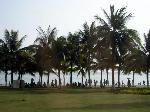
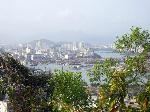
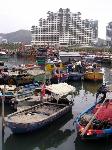
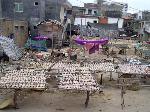
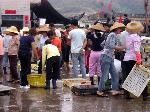

 Copyright © 1998-2025 All rights reserved.
Copyright © 1998-2025 All rights reserved.